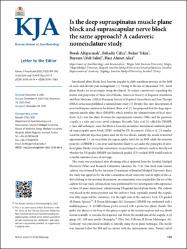Is the deep supraspinatus muscle plane block and suprascapular nerve block the same approach? A cadaveric nomenclature study

Göster/
Erişim
info:eu-repo/semantics/openAccessAttribution-NonCommercial 4.0 Internationalhttps://creativecommons.org/licenses/by-nc/4.0/Tarih
2022Üst veri
Tüm öğe kaydını gösterKünye
Altıparmak, B., Çiftçi, B., Tekin, B., Şakul, B. U. ve Alıcı, H. A. (2022). Is the deep supraspinatus muscle plane block and suprascapular nerve block the same approach? A cadaveric nomenclature study. Korean Journal of Anesthesiology, 75(2), 193-195. https://doi.org/10.4097/kja.21513Özet
Interfascial plane blocks have become popular in daily anesthesia practice in the field of acute and chronic pain management [1]. Owing to the use of ultrasound (US), novel plane blocks are increasingly being developed. To reduce controversy regarding the names and properties of these novel blocks, American Society of Regional Anesthesia and Pain Medicine (ASRA)-European Society of Regional Anaesthesia and Pain Therapy (ESRA) consensus published a nomenclature study [2]. Despite this, new descriptions of novel techniques continue to be defined. Kose et al. [3] has proposed that the deep supraspinatus muscle plane block (DSMPB), which involves the administration of local anesthetic (LA) into the plane between the supraspinatus muscles (SMs) and the posterior scapula, is a safer and easier novel technique. Recently, Teles et al. [4] called the DSMPB, a “new old technique” since the block is basically an indirect anatomical landmark-guided suprascapular nerve block (SNB) verified by US. In contrast, Ciftci et al. [5] emphasized the different injection points used for the two blocks, namely, the needle is inserted approximately 2.5 cm away from the suprascapular notch for an SNB, while the insertion point for a DSMPB is 4 cm away and therefore likely to act under the principles of interfacial plane blocks. Given this controversy, we performed a cadaveric study to directly test whether the US-guided DSMPB and landmark-guided (US-verified) SNB would result in a similar anatomical area of coverage.


















